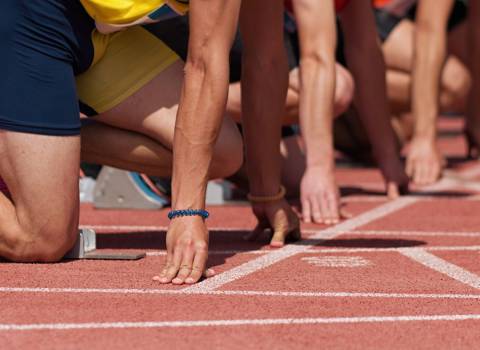The legal implications of Semi-Automated Offside Technology in professional football
The application of artificial intelligence across all industries is growing exponentially, most notably in the sport sector.
Artificial intelligence (AI) technology has been used across professional sports for over a decade. Hawk-Eye Technology (Hawk-Eye), for example, has been adopted across sports such as cricket, tennis, and football. Hawk-Eye uses multiple high-speed cameras and computer technology to track a ball’s movement during play and then process the camera footage to create a 3-dimensional representation of the ball’s trajectory at any given moment.
While Hawk-Eye has proven invaluable for officials in assisting their decision-making to date, the Premier League is going further to achieve fairness and consistency in its officiating by adopting a new Semi-Automated Offside Technology (SAOT) system, expected to be rolled out during the 2024-25 campaign.
This article explores the potential legal implications of the use of SAOT in professional football.
How does SAOT work?
SAOT is designed to improve the accuracy and efficiency of offside decisions in Premier League matches by combining advanced technologies to quickly and accurately determine if a player is offside during a build-up of play. The key features of this technology include:
- Limb-tracking cameras - these cameras capture the movements of players and the ball with high precision, tracking up to 29 data points on each player's body to determine their exact positions on the field.
- Trained data - AI then processes the data from the cameras to make offside determinations quickly and accurately. It can identify the precise moment the ball is played and the positions of the players relative to each other and the ball.
- 3D animation - SAOT then creates 3D animations to visually represent offside decisions, making it easier for referees, players, and fans to understand the circumstances and the reasoning behind the decisions made by the officials.
What are the potential benefits of SAOT?
SAOT purports to offer improvements on current technology, including:
- Increased accuracy - SAOT improves the precision of offside calls, reducing human error and ensuring that decisions are based on exact measurements of players' positions.
- Faster decision-making - the technology speeds up the decision-making process, reducing the time referees spend reviewing offside incidents and minimising game interruptions. By reducing the time taken for offside reviews, SAOT helps maintain the flow of the game, keeping it engaging for fans and fair for players.
- Consistency - the intention is that offside decisions become more consistent across matches, as the technology applies the same criteria and measurement of accuracy to every incident.
- Transparency - the 3D animations and data provided by SAOT can be shared with the public, making it easier for fans to understand and trust the decisions made by the on-pitch referee and assistant referees.
- Support for referees - this technology will provide real-time assistance, helping the match officials make correct decisions under the pressure of a live match and reducing the likelihood of contentious or controversial calls.
What are the key legal implications of SAOT and what should be done to manage these?
Data privacy and protection
- Key legal implications - under the UK GDPR, ‘Personal Data’ includes any information which relates to an identifiable natural person. SAOT will collect extensive data on each players' live images and movements. As such, photographs, and video recordings of the players, as well as their movements can be considered Personal Data, on the basis that they can be individually identified from that data.
- What should be done - in order to ensure compliance with UK data protection laws, the Premier League, and each of the clubs making use of this technology, should take all necessary steps to ensure that all data collected is adequately protected, used only for its intended purposes, and that each of the players are fully informed about how their data is used, and the appropriate permissions are sought prior to making use of the new technology.
Liability and accountability
- Key legal implications - if a club were to take the view that an official’s decision (influenced by SAOT) was incorrect, this could raise legal implications should the decision result in consequences such as loss of revenue, relegation, or even insolvency. Further, in the event of a technical malfunction, complex legal issues may arise in determining whether any losses suffered by an aggrieved party are the responsibility of the technology provider, the Premier League, or potentially other stakeholders.
- What should be done - the Football Association (FA) should implement clear rules governing the use of SAOT, and the impact of any decisions influenced using such technology. These rules should address clear lines of accountability in on-field decision-making, as well as a suitable appeal process for challenging questionable decisions, reducing the risk of costly litigation. Liability provisions in the AI service contracts will also need to be carefully considered by invested parties.
Transparency and fair play
- Key legal implications - the true value of the Premier League lies in maximising the weekly match attendance of dedicated and committed fans and maintaining the viewership across multiple streaming services. Ensuring the legal integrity, fairness and consistency of its officiating is therefore paramount.
- What should be done - maintaining transparency about how SAOT works and its impact on decision-making is crucial in ensuring public trust and avoiding reputational damage to the Premier League. The FA will need to ensure regular audits are carried out to identify any discrepancies or biases in the data used, as well as taking account of feedback from officials, players, and clubs. This process of continuous improvement will establish trust in the use of the technology.
What action should you take now?
The FA has recognised the potential benefits that SAOT offers and will, at some point during the 2024-25 campaign, officially roll it out. It remains to be seen how SAOT will impact the game going forward.
For clubs, players, and officials, internal governance and contracts should be reviewed to ensure compliance with the upcoming changes to the sport. For governing bodies and associations, now would be an ideal time to undergo an internal review of your constitutional documents and rules, supported by specialists with legal and regulatory expertise.
For further information, please contact Philip Bowers, Michael McKenna or Mark Hughes or call 0151 906 1000.





